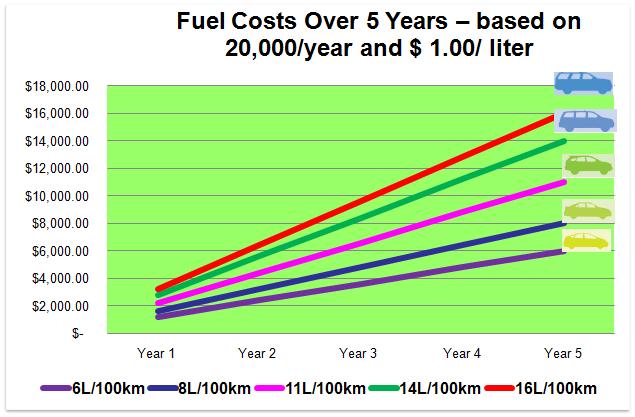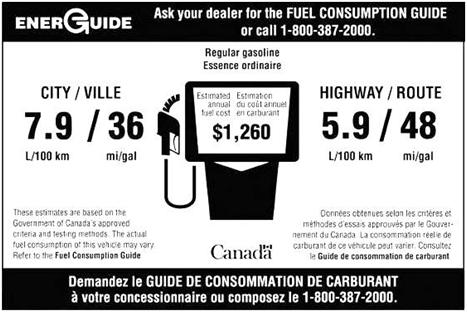There is no better time to consider fuel efficiency than when you are looking to buy a new or used vehicle. The choices you make can end up saving you thousands of dollars over time!
Here are some tips on how to compare vehicles, their real costs, and some of the options that you might want to consider when buying a new or used vehicle.
Fuel Economy
The actual fuel economy of the vehicle you choose today will make a significant difference in how much fuel you consume over time. The difference between the most fuel efficient sub-compact and the most fuel hungry SUV could cost you as much as $10,000.00 in just 5 years.

Source: Natural Resources Canada
The chart above is based on the Canadian average of 20,000 km/year and $1.00 per litre of fuel. As fuel costs rise, the difference over 5 years will be even more significant. Reducing your fuel consumption by making a smart vehicle purchase will also reduce your personal vehicle emissions.
Don’t forget that while a smaller engine generally means better fuel efficiency, you need look at the “actual” fuel efficiency for each and every vehicle you are considering. Cars are categorized according to interior size and fuel consumption within any category can vary widely depending on the specifics of the vehicle. Trucks are generally categorized by weight classes, but again considering actual fuel economy is important.
Buying New?
You need to know the actual fuel consumption for the specific vehicle you have in mind in order to understand it’s true operating costs. It is easy to understand that the bigger the vehicle, the more expensive it is to drive, however even within vehicle classes, the difference in fuel use can be more than double!

Source: Natural Resources Canada
When buying a new car check the fuel efficiency rating on the car’s EnerGuide label.
Buying a Used Vehicle?
If you are buying a used vehicle, you can visit the Natural Resources Canada website and look up the actual fuel consumption rating for the most vehicles from the 1995 model year to the present.
Other Things to Consider
There is more to consider than the color when choosing a vehicle, especially if you are thinking about fuel economy. Here are some things to consider and options that can greatly influence your fuel economy.
How does your vehicle fit into your lifestyle?
You should always think first about what your everyday use of your vehicle will be. How big, how much cargo space, how much power etc.
Do you really need a large SUV to get your 2 kids to school and their activities? Would a station wagon or hatchback would provide you with sufficient cargo space and at the same time use less fuel.
Do you really need a large 4 wheel drive truck to occasionally haul materials, or would a trailer work just as well? Could you rent or borrow what you need for the occasions when you need it? You might find that the money you save on gas with your more fuel-efficient vehicle will more than offset the cost of an occasional rental.
There are lots of choices that can save you money in the long run. In general, smaller vehicles will cost less to purchase and save you at the pump. The decisions that you make today will cost you for years to come!
What about vehicle options?
There are also many options to consider when purchasing a vehicle. These conveniences and accessories not only cost you when you purchase, but can also make a big difference in your fuel economy.
Here are some Fuel Savers you should consider:
- Manual Transmission: is lighter, and allows you to shift gears more efficiently, saving approximately 10% in overall fuel economy!
- Continuously Variable Transmission: 8-10% more efficient than a standard automatic transmission.
- Cruise Control: helps you drive smoothly and can eliminate inadvertent speeding, which reduces fuel economy.
- Aerodynamic Design: reduces drag, especially at highway speeds.
- Tinted Glass: reduces the need for air conditioning.
- Trip Computer or Fuel Efficiency Display: allows you to know your real-time fuel efficiency and improve your fuel saving habits.
Here are the Gas Guzzling options that you might choose to do without:
- A larger engine consumes more fuel and increases the weight of your vehicle.
- 4 Wheel or All Wheel Drive significantly increases fuel use and add more weight as well. This option could cost you 5 to 10%. Full time all wheel drive is the least fuel efficient choice because all 4 wheels are being driven all the time.
- Power Options that draw electrical power continuously such as heated seats, increase your fuel consumption. These accessories draw extra power from the alternator which, in turn, draws extra power from the engine.
- Other power options like power windows, seats, and sunroofs do not draw much power since they only operate briefly, however they add weight in the form of motors and controls that will affect your fuel consumption. Power seats alone can add 40 to 60 kilograms of weight and be a 2 to 3 % fuel consumption penalty.



Recent Comments